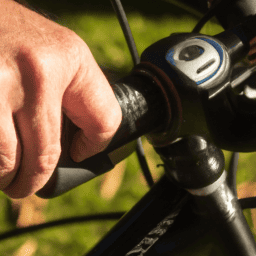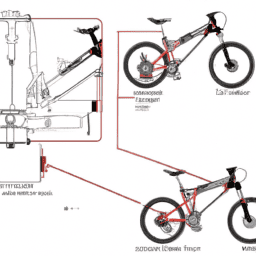Cycling can be compared to conducting a symphony on wheels. Similar to how a musician needs to be adept with the different instruments within an orchestra, a cyclist needs to understand how to properly utilize the different parts of their bicycle. Among these parts, the gear system stands out as crucial. Mastering the art of gear shifting on a bicycle is vital for ensuring a ride that’s both smooth and efficient.
When I first started cycling, I was intimidated by the gear system. However, after learning how to use it properly, I realized how much it can enhance my ride. In this article, I will share with you the techniques and tips I have learned for shifting gears on a bicycle.
Whether you are a beginner or an experienced cyclist, these tips will help you improve your performance on the road or trail. So, let’s dive into the details and learn how to shift gears like a pro!
Key Takeaways
- Understanding gear ratio calculation is important for efficient shifting
- Anticipating terrain changes and coordinating shifting with pedaling is crucial for maintaining momentum
- Proper hand placement, cable tension adjustments, and consistent pedaling speed contribute to a seamless shifting experience
- Body positioning, brake control, and wise choice of cadence help to avoid muscle strain and maintain a comfortable and efficient pedaling speed.
Understand Your Bike’s Gear System
Don’t be intimidated by your bike’s gear system, it’s actually pretty simple once you get the hang of it! The first thing you need to understand is gear ratio calculation.
The gears on your bike are designed to make pedaling easier or harder depending on the terrain you’re riding on. The gear ratio is calculated by dividing the number of teeth on the front chainring by the number of teeth on the rear cassette. The higher the gear ratio, the harder it is to pedal but the faster you’ll go. The lower the gear ratio, the easier it is to pedal but you’ll go slower.
There are two common gear system types: the derailleur and the internal hub. The derailleur system is the most common and consists of a chain running over two sets of gears, the front chainring and the rear cassette. The internal hub system is less common and consists of a single gear in the rear hub.
Both systems have advantages and disadvantages, but the derailleur system is more versatile and can handle a wider range of terrain.
Now that you understand the basics of your bike’s gear system, let’s move on to how to anticipate terrain changes.
Anticipate Terrain Changes
As you approach a hill or a change in road surface, it’s important to anticipate the terrain changes ahead of time so you can adjust your pedaling accordingly. To tackle an uphill, you should shift to a lower gear to make it easier to pedal and maintain a consistent cadence.
Maintaining momentum is also crucial, so avoid sudden braking or stopping if possible. Instead, use brake control to slow down gradually and maintain your speed as you shift gears.
Body positioning is also important when anticipating terrain changes. While climbing uphill, shift your weight forward to keep your front wheel on the ground and maintain traction. When descending, shift your weight back to maintain balance and control.
Remember to choose your cadence wisely and maintain a comfortable, efficient pedaling speed. With these techniques, you can tackle any terrain changes with ease and confidence. Use your shifters correctly to optimize your riding experience and smoothly transition between gears.
Use Your Shifters Correctly
To optimize your riding experience and effortlessly transition between different speeds, you should make sure to use your shifters correctly. Proper hand placement is crucial when using your shifters. Your right hand should be on the right shifter, which controls the rear derailleur that moves the chain across the rear cassette, while your left hand should be on the left shifter, which controls the front derailleur that moves the chain across the chainrings.
It’s also important to adjust cable tension to ensure smooth shifting. If your bike is not shifting smoothly, you may need to adjust the cable tension. To do this, locate the barrel adjuster on your shifter and turn it clockwise to tighten the cable or counterclockwise to loosen it. Making small adjustments to cable tension can make a big difference in how smoothly your bike shifts. With proper hand placement and cable tension adjustments, you can shift gears with ease and ride more efficiently. When shifting, it’s important to coordinate your shifting with your pedaling to ensure a smooth transition between gears.
Coordinate Shifting with Pedaling
Make sure you coordinate your pedaling with your gear changes for a seamless riding experience. When shifting gears on a bicycle, it’s important to understand that the timing of your shifts can have a significant impact on your overall performance.
One of the key aspects of coordinating your shifting with pedaling is to ensure that you’re not putting too much strain on your muscles. This means that you need to pay close attention to your pedaling technique and muscle engagement as you shift gears.
In general, it’s best to shift gears before you start climbing a hill or accelerating quickly. This way, you can ensure that you’re in the right gear to tackle the challenge ahead. When you shift gears, try to maintain a consistent pedaling speed as much as possible. This will help you avoid jerky movements or sudden changes in your muscle engagement, which can be jarring and uncomfortable.
By coordinating your shifting with your pedaling, you’ll be able to enjoy a smoother and more efficient ride overall.
As you become more comfortable with your bike and your shifting technique, you may want to experiment with different gear combinations to see how they affect your performance. Practice shifting gears on a variety of terrains and at different speeds to get a feel for how the bike responds.
With time and experience, you’ll be able to fine-tune your shifting technique to suit your needs and preferences. So, keep practicing and experimenting until you find the perfect combination that works for you.
Practice and Experiment
Get groovy and give different gear combinations a go to gauge your game on varying terrains and at different velocities. Experimenting techniques is key to mastering gear shifting on a bike. Take note of the gear combination that works best for you on different terrains and keep practicing until you feel comfortable with the changes.
Practicing with a partner can also help you improve your gear shifting skills. Have a friend ride alongside you and try shifting gears together. Practice shifting gears while going uphill and downhill, and experiment with different cadences.
Remember to pay attention to the sound and feel of your bike as you shift gears. With enough practice and experimentation, you’ll be able to shift gears smoothly and effortlessly.
Frequently Asked Questions
How often do I need to oil my bike’s gear system?
I typically oil my bike’s gear system every 100-150 miles. Using a high-quality lubricant can improve shifting performance, but be careful not to over-lubricate as this can attract dirt and grime. Regular cleaning and maintenance are essential for extending the lifespan of your bike’s gear system.
Can I shift gears while standing still?
Shifting gears while stationary is not recommended as it can damage the bike’s gear system. However, there are benefits to shifting while standing, such as improved control and power for uphill climbs. To properly shift gears for uphill climbs, anticipate the incline and shift to a lower gear before starting the ascent.
What should I do if my bike’s gears are not shifting smoothly?
When my bike’s gears are not shifting smoothly, I perform bike maintenance tips like cleaning the chain, adjusting the derailleur, and lubricating the cables. Troubleshooting gear issues may require replacing worn parts or seeking professional help.
Do I need to change gears when going uphill?
While it’s not necessary, changing gears when going uphill has its pros and cons. Techniques such as anticipating the hill and shifting before it becomes too steep can make the climb easier.
Is it better to shift to a higher or lower gear when coming to a stop?
When coming to a stop, it’s better to shift to a lower gear to make it easier to restart. Using a higher gear can cause chain slipping. Always remember the benefits of using a lower gear vs a higher gear when starting.
Conclusion
So that’s how you shift gears on a bicycle. It may seem like a lot to take in at first, but with practice and experimentation, you’ll get the hang of it. Remember to anticipate terrain changes and use your shifters correctly to make your ride smoother and more efficient.
But shifting gears on a bike isn’t just about the technicalities. It’s about the feeling of the wind in your hair as you speed down a hill, and the satisfaction of conquering a tough climb.
It’s about the freedom and joy that comes with being on a bicycle. So don’t be afraid to take on new challenges and explore new roads.
With these gear-shifting tips in mind, you’re ready to take your cycling adventures to the next level.









